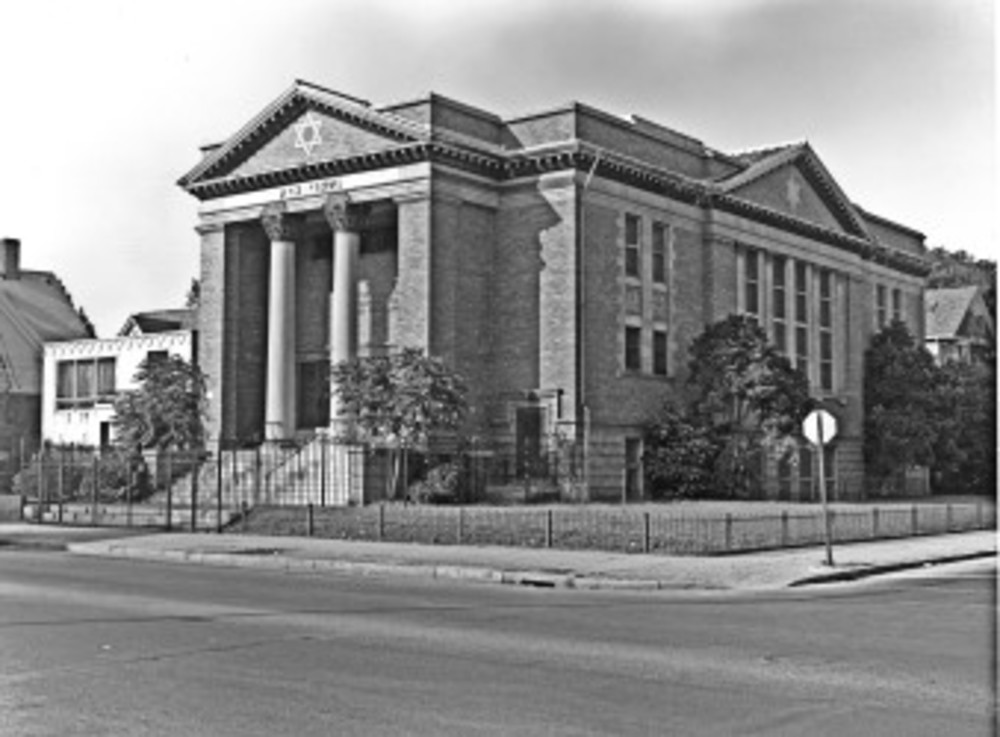A Tale of Two Synagogues
 If you enter Eldridge Street in New York City from Division, you feel as though you had entered a foreign country. The cars parked nearby or trying to navigate its narrow confines bear New York license plates, but the language you hear on the crowded street and see emblazoned on storefronts is Chinese. Then you see #12 Eldridge Street, a large, red brick, “Moorish style” building, it is the Eldridge Street Synagogue, Kahal Adath Jeshurun. An anomaly now in the midst of Chinatown, it was once the centerpiece of a large, thriving Jewish community in the Lower East Side.
If you enter Eldridge Street in New York City from Division, you feel as though you had entered a foreign country. The cars parked nearby or trying to navigate its narrow confines bear New York license plates, but the language you hear on the crowded street and see emblazoned on storefronts is Chinese. Then you see #12 Eldridge Street, a large, red brick, “Moorish style” building, it is the Eldridge Street Synagogue, Kahal Adath Jeshurun. An anomaly now in the midst of Chinatown, it was once the centerpiece of a large, thriving Jewish community in the Lower East Side.
The synagogue, completed and dedicated in 1887, opened its doors in time for Rosh Hashanah that year. It was the first Ashkenazi shul built exclusively as a house of worship. The imposing size, the Stars of David decorating its façade announced to the world We are here. We have arrived. Light, diffused by the many stained glass windows patterned with Stars of David and circles, poured into the sanctuary, whose vaulted ceiling rose to a height of 50 feet. A huge brass chandelier and intricately carved woodwork added to the decorations, while gold five-pointed stars gleamed on the dark blue ceiling.
By the 1940’s membership had dropped, and the synagogue fell into decline. Other immigrants now crowded the street. A rescue effort began in 1986. Twenty years and 18.5 million dollars later, the synagogue was lovingly and authentically restored to its former ostentation and beauty in every detail save one. The original rose window over the Ark, broken 40 years earlier, could not be replicated, as its design plan was lost. Its replacement, however, is stunning.
Eldridge Street Synagogue is now home to a museum and a small congregation. It is also a venue for concerts and cultural programs.
On the eve of Rosh Hashanah, 1911, the Congregation Sons of Israel and David, the first Jewish congregation in Providence, dedicated their new synagogue. Known as Temple Beth-El, the building was located at the corner of Broad and Glenham Streets, away from the bustling area of South Providence where immigrants were settling. The Providence Journal hailed it as “…a notable step in the development of the Jewish community..” and referred to its beauty and elegance.
The building’s new-classical design had nothing in common with the “Moorish Style” of much synagogue architecture of the times. A single Magen David placed on the pediment above the two columns in front of the grey brick building marked it as a synagogue, and a flight of ten steps led up to the entrance. On a personal note, going up the steps in spike heels was negotiable; coming down could be treacherous.
The interior was simple. Stained glass windows depicting biblical scenes cast a warm glow on the white walls; the bimah and the Ark were the focus of your attention and eyes. The only touch of gold was the organ pipes. It was a serene, welcoming space that did not proclaim, but stated quite clearly: We are here. We are no longer newcomers.
By the 1940’s the burgeoning membership and the changing demographics made a change of address necessary. And so, a new Temple Beth-El replaced the original. The building name was changed to Congregation Shaare Zedek, and it became home to an orthodox congregation.
Once again time and demographics took their toll. An anomaly in an area where few, if any, Jews still live, it stands empty, ravaged by neglect. It is now the foc us of the Broad Street Synagogue Project, a group interested in preserving the building, its history and artifacts. Will its path parallel that of the Eldridge St. Synagogue or perhaps become a community center or a venue for the arts? Perhaps. The enthusiasm is there. Will the funding follow?
GERALDINE FOSTER is a past president of the Rhode Island Jewish Historical Association. To comment about this or any Rhode Island Jewish Historical Association article, email info@rijha.org.







